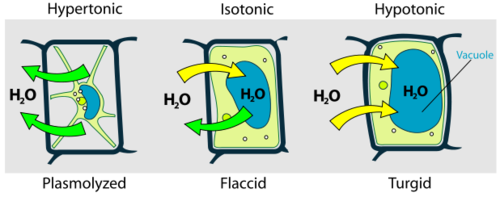Resistance to flow by membrane
 In calculating the
osmotic pressure
, we found a relationship between the pressure across a membrane and the flux of liquid across it,
.
In calculating the
osmotic pressure
, we found a relationship between the pressure across a membrane and the flux of liquid across it,
.
We can flip this relation around and expose a powerful perspective:
Does this look familiar?
In fact, this has the same form as Ohm's circuit law, .
Here, our rate of volume flow is akin to current, the osmotic pressure takes the place of voltage, and the resistance is given by the inverse of hydraulic conductivity times surface area of the membrane. I.e.
In any situation where we have a flow resulting from a pressure, we can characterize the circuit element (membrane, pipe, etc.) according to this ratio ( ), which we call the hydraulic resistance .
Calculate the hydraulic resistance (in Pascal seconds per meter ) of the semipermeable membrane connecting xylem and phloem,
Assumptions
- The length of the xylem:phloem section is 0.1 m
- The radius of the phloem is 20 m
- The hydraulic permeability of the membrane is 5 m/s/Pa
The answer is 1.59E+18.
This section requires Javascript.
You are seeing this because something didn't load right. We suggest you, (a) try
refreshing the page, (b) enabling javascript if it is disabled on your browser and,
finally, (c)
loading the
non-javascript version of this page
. We're sorry about the hassle.
If one models the membrane as a cylinder, then all we have is simple algebra:
R = 2 π r h L p 1 = 2 π × 2 0 × 1 0 − 6 0 . 1 × 5 × 1 0 − 1 4 1 = 1 . 5 9 × 1 0 1 8 Pa s/m 3 .